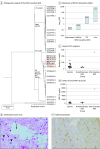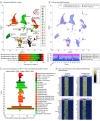Multiomic Analysis of Neuroinflammation and Occult Infection in Sudden Infant Death Syndrome
- PMID: 38285456
- PMCID: PMC10825787
- DOI: 10.1001/jamaneurol.2023.5387
Multiomic Analysis of Neuroinflammation and Occult Infection in Sudden Infant Death Syndrome
Abstract
Importance: Antemortem infection is a risk factor for sudden infant death syndrome (SIDS)-the leading postneonatal cause of infant mortality in the developed world. Manifestations of infection and inflammation are not always apparent in clinical settings or by standard autopsy; thus, enhanced resolution approaches are needed.
Objective: To ascertain whether a subset of SIDS cases is associated with neuroinflammation and occult infection.
Design, setting, and participants: In this case-control study, postmortem fluids from SIDS cases and controls collected between July 2011 and November 2018 were screened for elevated inflammatory markers, specifically cerebrospinal fluid (CSF) neopterin and CSF and serum cytokines. CSF, liver, and brain tissue from SIDS cases with elevated CSF neopterin were subjected to metagenomic next-generation sequencing (mNGS) to probe for infectious pathogens. Brainstem tissue from a subset of these cases was analyzed by single-nucleus RNA sequencing (snRNAseq) to measure cell type-specific gene expression associated with neuroinflammation and infection. All tissue and fluid analyses were performed from April 2019 to January 2023 in a pathology research laboratory. Included was autopsy material from infants dying of SIDS and age-matched controls dying of known causes.
Exposures: There were no interventions or exposures.
Main outcomes and measures: CSF neopterin levels were measured by high-performance liquid chromatography. Cytokines were measured by multiplex fluorometric assay. mNGS was performed on liver, CSF, brain, and brainstem tissue. snRNAseq was performed on brainstem tissue.
Results: A cohort of 71 SIDS cases (mean [SD] age, 55.2 [11.4] postconceptional weeks; 42 male [59.2%]) and 20 controls (mean [SD] age, 63.2 [16.9] postconceptional weeks; 11 male [55.0%]) had CSF and/or serum available. CSF neopterin was screened in 64 SIDS cases and 15 controls, with no exclusions. Tissues from 6 SIDS cases were further analyzed. For CSF neopterin measures, SIDS samples were from infants with mean (SD) age of 54.5 (11.3) postconceptional weeks (38 male [59.4%]) and control samples were from infants with mean (SD) age of 61.5 (17.4) postconceptional weeks (7 male [46.7%]). A total of 6 SIDS cases (9.3%) with high CSF neopterin were identified, suggestive of neuroinflammation. mNGS detected human parechovirus 3 (HPeV3) in tissue and CSF from 1 of these 6 cases. snRNAseq of HPeV3-positive brainstem tissue (medulla) revealed dramatic enrichment of transcripts for genes with predominately inflammatory functions compared with 3 age-matched SIDS cases with normal CSF neopterin levels.
Conclusions and relevance: Next-generation molecular tools in autopsy tissue provide novel insight into pathogens that go unrecognized by normal autopsy methodology, including in infants dying suddenly and unexpectedly.
Conflict of interest statement
Figures



Comment in
-
Brainstem Encephalitis as a Cause of Sudden Infant Death Syndrome.JAMA Neurol. 2024 Mar 1;81(3):231-232. doi: 10.1001/jamaneurol.2023.5384. JAMA Neurol. 2024. PMID: 38285466 No abstract available.
References
-
- Goldstein RD, Blair PS, Sens MA, et al. . Inconsistent classification of unexplained sudden deaths in infants and children hinders surveillance, prevention and research: recommendations from The 3rd International Congress on Sudden Infant and Child Death. Forensic Sci Med Pathol. 2019;15(4):622-628. doi:10.1007/s12024-019-00156-9 - DOI - PMC - PubMed
-
- Opdal S. Cytokines, infection, and immunity. In: Duncan JR, Byard RW, eds. SIDS Sudden Infant and Early Childhood Death. University of Adelaide Press; 2018:689-710. - PubMed
-
- Molero-Luis M, Fernández-Ureña S, Jordán I, et al. ; Neopterin Working Group . Cerebrospinal fluid neopterin analysis in neuropediatric patients: establishment of a new cut off-value for the identification of inflammatory-immune mediated processes. PLoS One. 2013;8(12):e83237. doi:10.1371/journal.pone.0083237 - DOI - PMC - PubMed
Publication types
MeSH terms
Substances
Grants and funding
LinkOut - more resources
Full Text Sources
Medical
Molecular Biology Databases
Miscellaneous

